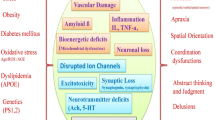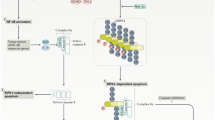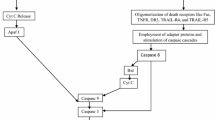Abstract
While defective apoptosis predisposes to neoplasia, inappropriate apoptosis in the brain leads to permanent neurological deficits. Disregulated apoptosis has been implicated in several neurodegenerative disorders including Alzheimer's, Parkinson's, and Huntington's diseases. Recent reports have suggested that the key apoptosis regulator Fas ligand (FasL) may participate in both neuronal and immune cell apoptosis in Alzheimer's disease. FasL has also been implicated as a negative regulator for the inflammatory component of the demyelinating brain disorder multiple sclerosis (MS). Here we discuss how FasL-mediated apoptosis may balance immune cell access to the brain with Alzheimer's disease and MS representing extremes of too little and too much immune access, respectively.
Similar content being viewed by others
References
Li P, Nijhawan D, Budihardjo I, Srinivasula SM, Ahmad M, Alnemri ES, Wang X: Cytochrome c and dATP-dependent formation of Apaf-1/caspase-9 complex initiates an apoptotic protease cascade. Cell 91:479–489, 1997
Peter ME, Krammer PH: The CD95(APO-1/Fas) DISC and beyond. Cell Death Differ 10:26–35, 2003
Hemmer B, Archelos JJ, Hartung HP: New concepts in the immunopathogenesis of multiple sclerosis. Nat Rev Neurosci 3:291–301, 2002
Swanborg RH: Experimental autoimmune encephalomyelitis in rodents as a model for human demyelinating disease. Clin Immunol Immunopathol 77:4–13, 1995
Hartung HP, Kieseier BC: The role of matrix metalloproteinases in autoimmune damage to the central and peripheral nervous system. J Neuroimmunol 107:140–147, 2000
Wildbaum G, Westermann J, Maor G, Karin N: A targeted DNA vaccine encoding Fas ligand defines its dual role in the regulation ofexperimental autoimmune encephalomyelitis. J Clin Invest 106:671–679, 2000
Brossart P, Brevan MJ: Selective activation of Fas/Fas ligand-mediated cytotoxicity by a self peptide. J Exp Med 183:2449–2458, 1996
Alderson MR, Tough TW, Davis-Smith T, Braddy S, Falk B, Schooley KA, Goodwin RG, Smith CA, Ramsdell F, Lynch DH: Fas ligand mediates activation-induced cell death in human T lymphocytes. J Exp Med 181:71–77, 1995
Brunner T, Mogil RJ, LaFace D, Yoo NJ, Mahboubi A, Echeverri F, Martin SJ, Force WR, Lynch DH, Ware CF, Green DR: Cell-autonomous Fas (CD95)/Fas-ligand interaction mediates activation-induced apoptosis in T-cell hybridomas. Nature 373:441–444, 1995
Dhein J, Walczak H, Baumler C, Debatin K-M, Krammer PH: Autocrine T cell suicide mediated by APO-1/(Fas/CD95). Nature 373:438–441, 1995
Ju S-T, Panka DJ, Cui H, Ettinger R, El-Khatib M, Sherr DH, Stanger BZ, Marshak-Rothstein A: Fas (CD95)/FasL interactions required for programmed cell death after T cell activation. Nature 373:444–448, 1995
Tabi Z, McCombe PA, Pender MP: Apoptotic elimination of Vβ8.2+ cells from the central nervous system during recovery from experimental autoimmune encephalomyelitis induced by the passive transfer of Vβ8.2+ encephalitogenic T cells. Eur J Immunol 24:2609–2617, 1994
Tabi Z, McCombe PA, Pender MP: Antigen-specific down-regulation of myelin basic protein-reactive T cells during spontaneous recovery from experimental autoimmune encephalomyelitis: Further evidence of apoptotic deletion of autoreactive T cells in the central nervous system. Int Immunol 7:967–973, 1995
Ishigami T, White CA, Pender MP: Soluble antigen therapy induces apoptosis of autoreactive T cells preferentially in the target organ rather than in the peripheral lymphoid organs. Eur J Immunol 28:1626–1635, 1998
Matsumoto Y, Hara N, Tanaka R, Fujiwara M: Immunohistochemical analysis of the rat central nervous system during experimental allergic encephalomyelitis, with special reference to Ia-positive cells with dendritic morphology. J Immunol 136:3668–3676, 1986
Ford AL, Foulcher E, Lemckert FA, Sedgwick JD: Microglia induce CD4 T lymphocyte final effector function and death. J Exp Med 184:1737–1745, 1996
Matsumoto Y, Ohmori K, Fujiwara M: Immune regulation by brain cells in the central nervous system: Microglia but not astrocytes present myelin basic protein to encephalitogenic T cells under in vivo-mimicking conditions. Immunology 76:209–216, 1992
Becher B, Barker PA, Owens T, Antel JP: CD95—CD95L: Can the brain learn from the immune system? Trends Neurosci 21:114–117, 1998
Bechmann I, Mor G, Nilsen J, Eliza M, Nitsch R, Naftolin F: FasL (CD95L, Apo1L) is expressed in the normal rat and human brain: Evidence for the existence of an immunological brain barrier. Glia27:62–74, 1999
Frigerio S, Silei V, Ciusani E, Massa G, Lauro GM, Salmaggi A: Modulation of Fas-Ligand (Fas-L) on human microglial cells: An in vitro study. J Neuroimmunol 105:109–114, 2000
Flugel A, Schwaiger FW, Neumann H, Medana I, Willem M,Wekerle H, Kreutzberg GW, Graeber MB: Neuronal FasL induces cell death of encephalitogenic T lymphocytes. Brain Pathol 10:353–364, 2000
Choi C, Park JY, Lee J, Lim J-H, Shin E-C, Ahn YS, Kim C-H, Kim S-J, Kim J-D, Choi IS, Choi I-H: Fas ligand and Fas are expressed constitutively in human astrocytes and the expression increases with IL-1, IL-6, TNF-α, or IFN-γ. J Immunol 162:1889–1895, 1999
Pender MP: Activation-induced apoptosis of autoreactive and alloreactive T lymphocytes in the target organ as a major mechanism of tolerance. Immunol Cell Biol 77:216–223, 1999
Ferguson TA, Green DR, Griffiths TS: Cell death and immune privilege. Int Rev Immunol 21:153–172, 2002
Griffith TS, Brunner T, Fletcher SM, Green DR, Ferguson TA: Fas ligand-induced apoptosis as a mechanism of immune privilege. Science 270:1189–1192, 1995
Griffith TS, Yu X, Herndon JM, Green DR, Ferguson TA: CD95—induced apoptosis of lymphocytes in an immune privileged site induces immunological tolerance. Immunity 5:7–16, 1996
Sabelko-Downes KA, Cross AH, Russell JH: Dual role for Fas ligand in the initiation of and recovery from experimental allergicencephalomyelitis. J Exp Med 189:1195–1205, 1999
Bonetti B, Raine CS: Multiple sclerosis: Oligodendrocytes display cell death-related molecules in situ but do not undergo apoptosis. Ann Neurol 42:74–84, 1997
Huang W-X, Huang MP, Gomes MA, Hillert J: Apoptosis mediators of FasL and TRAIL are upregulated in peripheral blood mononuclear cells in MS. Neurology 55:928–934, 2000
Gomes AC, Jonsson G, Mjornheim S, Olsson T, Hillert J, Grandien A: Upregulation of the apoptosis regulators cFLIP, CD95 and CD95 ligand inperipheral blood mononuclear cells in relapsing—remitting multiple sclerosis. J Neuroimmunol 135:126–134, 2003
Nagata S: Human autoimmune lymphoproliferative syndrome, adefect in the apoptosis-inducing Fas receptor: A lesson from the mouse model. J Hum Genet 43:2–8, 1998
Nagata S, Suda T: Fas and Fas ligand: Ipr and gld mutations. Immunol Today 16:39–43, 1995
Matsuno H, Yudoh K, Watanabe Y, Nakazawa F, Aono H, Kimura T: Stromelysin-1 (MMP-3) in synovial fluid of patients with rheumatoid arthritis has potential to cleave membrane bound Fas ligand. J Rheumatol 28:22–28, 2001
Mitsiades N, Poulaki V, Mitsiades CS, Anderson KC: Induction of tumour cell apoptosis by matrix metalloproteinase inhibitors: New tricks for a (not so) old drug. Expert Opin Investig Drugs 10:1075-1084
Vargo-Gogola T, Crawford HC, Fingleton B, Matrisian LM: Identification of novel matrix metalloproteinase-7 (matrilysin) cleavage sites in murine and human Fas ligand. Arch Biochem Biophys 408:155–161, 2002
Suda T, Hashimoto H, Tanaka M, Ochi T, Nagata S: Membrane Fas ligand kills human peripheral blood T lymphocytes, and soluble Fas ligand blocks the killing. J Exp Med 186:2045–2050, 1997
Hewson AK, Smith T, Leonard JP, Cuzner ML: Suppression of experimental allergic encephalomyelitis in the Lewis rat by the matrix metalloproteinase inhibitor Ro31–9790. Inflamm Res 44:345–349, 1995
Clements JM, Cossins JA, Wells GM, Corkill DJ, Helfrich K, Wood LM, Pigott R, Stabler G, Ward GA, Gearing AJ, Miller KM: Matrix metalloproteinase expression during experimental autoimmune encephalomyelitis and effects of a combined matrix metalloproteinase and tumour necrosis factor-alpha inhibitor. J Neuroimmunol 74:85–94, 1997
Brooks PC, Stromblad S, Sanders LC, von Schalscha TL, Aimes RT, Stetler-Stevenson WG, Quigley JP, Cheresh DA: Localization of matrix metalloproteinase MMP-2 to the surface of invasive cells by interaction with integrin alpha v beta 3. Cell 85:683–693, 1996
Silletti S, Kessler T, Goldberg J, Boger DL, Cheresh DA: Disruption of matrix metalloproteinase 2 binding to integrin alpha vbeta 3 by an inorganic molecule inhibits angiogenesis and tumor growth in vivo. Proc Natl Acad Sci USA 98:119–124, 2001
Seino K, Iwabuchi K, Kayagaki N, Miyata R, Nagaoka I, Matsuzawa A, Fukao K, Yagita H, Okumura: Chemotactic activity of soluble Fas ligand against phagocytes. J Immunol 161:4484–4488, 1998
Meyer R, Weissert R, Diem R, Storch MK, de Graaf KL, Kramer B, Bahr M: Acute neuronal apoptosis in a rat model of multiple sclerosis. J Neurosci 21:6214–6220, 2001
Ouallet J, Baumann N, Marie Y, Villarroya H: Fas system up-regulation in experimental autoimmune encephalomyelitis. J Neurol Sci 170:96–104, 1999
Martin-Villalba A, Herr I, Jeremias I, Hahne M, Brandt R, Vogel J, Schenkel J, Herdegen T, Debatin KM: CD95 ligand (Fas-L/APO-1L) and tumor necrosis factor-related apoptosis-inducing ligand mediate ischemia-induced apoptosis in neurons. J Neurosci 19:3809–3817, 1999
Zurita M, Vaquero J, Zurita I: Presence and significance of CD-95 (Fas/APO1) expression after spinal cord injury. J Neurosurg 94:257–264, 2001
Anthony DC, Ferguson B, Matyzak MK, Miller KM, Esiri MM, Perry VH: Differential matrix metalloproteinase expression in cases of multiple sclerosis and stroke. Neuropathol Appl Neurobiol 23:406–415, 1997
Matsushita K, Wu Y, Qiu J, Lang-Lazdunski L, Hirt L, Waeber C, Hyman BT, Yuan J, Moskowitz MA: Fas receptor and neuronal death after spinal cord ischemia. J Neurosci 20:6879–6887, 2000
Ethell DW, Kinloch, R, Green DR: Metalloproteinase shedding of FasL regulates beta-amyloid neurotoxicity. Curr Biol 12:1595–1600, 2002
Vassar R, Citron M: Abeta-generating enzymes: Recent advances in beta-and gamma-secreatase research. Neuron 27:419–422, 2000
Chen G, Chen KS, Knox J, Inglis J, Bernard A, Martin SJ, Justice A, McConlogue L, Games D, Freedman SB, Morris RG: A learning deficit relatd to age and beta-amyloid plaques in a mouse model of Alzheimer's disease. Nature 408:975–979, 2000
Selkoe D: Deciphering the genesis and fate of amyloid beta-protein yields novel therapies for Alzheimer disease. J Clin Invest 110:1375–1381, 2002
Selznick LA, Holtzman DM, Han BH, Goken M, Srinivasan AN, Johnson EM, Roth KA: In situ immunodetection of neuronal caspase-3 activation in Alzheimer's disease. J Neuropathol Exp Neurol 59:1020–1026, 1999
Rohn TT, Head E, Su JH, Anderson AJ, Bahr BA, Cotman CW, Cribbs DH: Correlation between caspase activation and neurofibrillary tangle formation in Alzheimer's disease. Am J Pathol 158:189–198, 2001
Su JH, Zhao M, Anderson AJ, Srinivasan A, Cotman CW: Activated caspase-3 expression in Alzheimer's and aged control brain: Correlation with Alzheimer pathology. Brain Res 898:350–357, 2001
Harada J, Sugimoto M: Activation of caspase-3 in beta-amyloid-induced apoptosis of cultured rat cortical neurons. Brain Res 842:311–323, 1999
Ivins KJ, Thornton PL, Rohn TT, Cotman CW: Neuronal apoptosis induced by beta-amyloid is mediated by caspase-8. Neurobiol Dis 6:440–449, 1999
de la Monte SM, Sohn YK, Wands JR: Correlates of p53–and Fas (CD95)-mediated apoptosis in Alzheimer's disease. J Neurol Sci 152:73–83, 1997
Morishima Y, Gotoh Y, Zieg J, Barrett T, Takano H, Flavell R, Davis RJ, Shirasaki Y, Greenberg ME: Beta-amyloid induces neuronal apoptosis via a mechanism that involves the c-Jun N-terminal kinase pathway and the induction of Fas ligand. J Neurosci 21:7551–7560, 2001
Tanaka M, Itai T, Adachi M, Nagata S: Downregulation of Fas ligand by shedding. Nat Med 4:31–36, 1998
Mogi M, Fukuo K, Yang J, Suhara T, Ogihara T: Hypoxia stimulates release of the soluble form of Fas ligand that inhibits endothelial cell apoptosis. Lab Invest 81:177–184, 2001
Asai M, Hattori C, Szabo B, Sasagawa N, Maruyama K, Tanuma S, Ishiura S: Putative function of ADAM9, ADAN10 and ADAM17 as APP alpha-secretase. Biochem Biophys Res Commun 301:231–235, 2003
Hartmann D, de Strooper B, Semeels L, Craessaerts K, Herreman A, Annaert W, Umans L, Lubke T, Lena Illert A, von Figura K, Saftig P: The disintegrin/metalloproteinase ADAM 10 is essential for notch signaling but not for alpha-secretase activity in fibroblasts. Hum Mol Genet 11:2615–2624, 2002
Black RA: Tumor necrosis factor-alpha converting enzyme. Int J Biochem Cell Biol 34:1–5, 2002
Eikelenboom P, Zhan SS, van Gool WA, Allsop D: Inflammatory mechanisms in Alzheimer's disease. Trends Pharmacol Sci 15:147–150, 1994
Cagnin A, Brooks DJ, Kennedy AM, Gunn RN, Myers R, Turkheimer FE, Jones T, Banati RB: In-vivo measurement of microglia in dementia. Lancet 358:461–467, 2001
El Khoury J, Hickman SE, Thomas CA, Loike JD, Silverstein SC: Microglia, scavenger receptors, and the pathogensis of Alzheimer's disease. Neurobiol Aging 19:S81-S84, 1998
Sly LM, Krzesicki RF, Brashler JR, Buhl AE, McKinley DD, Carter DB, Chin JE: Endogenous brain cytokine mRNA and inflammatory responses to lipopolysaccharide are elevated in the Tg2576 transgenic mouse model of Alzheimer's disease. Brain Res Bull 56:581–588, 2001
Spanaus KS, Schlapbach R, Fontana A: TNF-alpha and IFN-gamma render microglia sensitive to Fas ligand-induced apoptosis by induction of Fas expression and downregulation of Bcl-2 and Bcl-XL. Eur J Immunol 28:4398–4408, 1998
Schlapbach R, Spanaus KS, Malipiero U, Lens S, Tasinato, Tschopp J, Fontana A: TGF-beta induces the expression of the FLICE inhibitor protein and inhibits Fas-mediated apoptosis of microglia. Eur J Immunol 30:3680–3688, 2000
Rescigno M, Piguet V, Valzasina B, Lens S, Zubler R, French L, Kindler V, Tschopp J, Ricciardi-Castagnoli P: Fas engagement induces the maturation of dendritic cells (DCs), the release of interleukin (IL)-1beta, and the production of interferon gamma in the absence of IL-12 during DC-T cell cognate interaction: A new role for Fas ligand in inflammatory responses. J Exp Med 192:1661–1668, 2000
Maedler K, Fontana A, Ris F, Sergeev P, Toso C, Oberholzer J, Lehmann R, Bachmann F, Tasinato A, Spinas GA, Halban P, Donath M: FLIP switches Fas-mediated glucose signaling in human pancreatic β cells from apoptosis to cell replication. Proc Natl Acad Sci USA 99:8236–8241, 2002
McGeer PL, McGeer EG: Inflammation of the brain in Alzheimer's disease: Implications for therapy. J Leukoc Biol 56:409–415, 1999
Akiyama H, et al.: Inflammation and Alzheimer's disease. Neurobiol Aging 21:383–421, 2000
Wyss-Coray T, Yan F, Lin AH, Lambris JD, Alexander JJ, Quigg RJ, Masliah E: Prominent neurodegeneration and increased plaque formation in complement-inhibited Alzheimer's mice. Proc Natl Acad Sci USA 99:10837–10842, 2002
McGeer PL, Schultzer M, McGeer EG: Arthritis and anti-inflammatory agents as possible protective factors for Alzheimer's disease: A review of 17 epidemiological studies. Neurology 47:425–432, 1996
Aisen PS: Anti-inflammatory agents in Alzheimer's disease. Curr Neurol Neurosci Rep 2:405–409, 2002
Janus C, Pearson J, McLaurin J, Mathews PM, Jiang Y, Schmidt SD, Chishti MA, Horne P, Heslin D, French J, Mount HT, Nixon RA, Mercken M, Bergeron C, Fraser PE, St George-Hyslop P, Westaway D: A beta peptide immunization reduces behavioural impairment and plaques in a model of Alzheimer's disease. Nature 408:979–982, 2000
Morgan D, Diamond DM, Gottschall PE, Ugen KE, Dickey C, Hardy J, Duff K, Jantzen P, DiCarlo G, Wilcock D, Connor K, Hatcher J, Hope C, Gordon M, Arendash GW: A beta peptide vaccination prevents memory loss in an animal model of Alzheimer's disease. Nature 406:982–985, 2000
Eikelenboom P, Hoogendijk WJG, Jonker C, van Tilburg W: Immunological mechanisms and the spectrum of psychiatric syndromes in Alzheimer's disease. J Psychiatry Res 36:269–280, 2002
Furlan R, Brambilla E, Sanvito F, Roccatagliata L, Olivieri S, Bergami A, Pluchino S, Uccelli A, Comi G, Martino G: Vaccination with amyloid-β peptide induces autoimmune encephalomyelitis in C57BL/6 mice. Brain 126:285–291, 2003
Bacskai BJ, Kajdasz ST, McLellan ME, Games D, Seubert P, Schenk D, Hyman BT: Non-Fc-mediated mechanisms are involved in clearance of amyloid-beta in vivo by immunotherapy. J Neurosci 22:7873–7878, 2002
Krammer PH: CD95's deadly mission in the immune system. Nature 407:789–795, 2000
Author information
Authors and Affiliations
Corresponding author
Rights and permissions
About this article
Cite this article
Ethell, D.W., Buhler, L.A. Fas Ligand-Mediated Apoptosis in Degenerative Disorders of the Brain. J Clin Immunol 23, 439–446 (2003). https://doi.org/10.1023/B:JOCI.0000010420.96419.a8
Issue Date:
DOI: https://doi.org/10.1023/B:JOCI.0000010420.96419.a8




